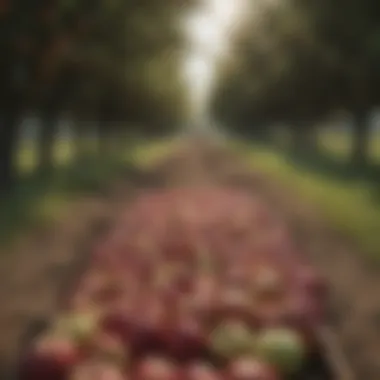Exploring Apple Farming Services in Covington


Intro
Understanding the agricultural potential of apple farm services in Covington is crucial for both local farmers and enthusiasts. Apple cultivation plays a significant role in the region, given its diverse climate and soil conditions that are favorable for growing various apple varieties. This article aims to explore not only the services offered but also how these services contribute to the overall agricultural landscape.
In recent years, there has been a shift toward sustainable practices in apple farming due to increasing consumer demand for eco-friendly products. By addressing key techniques, innovations, and practical applications, we will provide insights that can be beneficial for those involved in apple farming or interested in its prospects.
Topic Overview
Definition and Importance
Apple farm services encompass a range of practices essential for the successful cultivation of apples. These services include planting, maintenance, pest control, and harvest processes. Understanding these aspects helps farmers maximize their yield and maintain fruit quality. Moreover, the importance of these services extends to local economies, as apple farming creates jobs and supports associated industries.
Brief History and Evolution
The history of apple cultivation in Covington can be traced back to settlers who recognized the area's potential for growing apples. Over time, farming practices have evolved significantly. Traditional methods have slowly integrated with modern technology, optimizing efficiency and productivity. The introduction of new apple species has also contributed to increased variety in the market, leading to richer consumer choices.
Key Techniques and Innovations
Sustainable Farming Practices
Sustainable farming practices in apple cultivation focus on minimizing environmental impact. Techniques such as integrated pest management, organic fertilizers, and crop rotation are becoming standard methods. These practices not only promote ecological balance but also respond to market demands for sustainable products.
- Integrated Pest Management: This reduces reliance on chemical pesticides by combining biological control with minimal chemical use.
- Organic Farming: Utilizing natural methods for fertilization and weed control, thereby improving soil health and reducing pollution.
Advanced Agronomic Technologies
Advancements in technology have reshaped apple farming. Innovative tools such as drones, sensors, and precision agriculture software are becoming common. These technologies allow farmers to monitor their orchards more effectively and gather data that can guide decision-making. For example:
- Drones for aerial imagery, helping identify areas in need of attention.
- Smart Irrigation Systems that optimize water usage and improve crop yield.
Practical Applications
Step-by-Step Guides
For those interested in implementing these practices, here are some steps to consider:
- Soil Testing: Before planting, test the soil to determine nutrient levels and pH balance.
- Choosing Varieties: Select apple varieties that are best suited for the local climate.
- Site Preparation: Prepare fields by ensuring appropriate drainage and preventing erosion.
- Planting and Maintenance: Follow guidelines for planting and regular maintenance to ensure healthy growth.
Case Studies or Real-World Examples
Examining successful apple farms in Covington reveals much about effective practices. For instance, Sunny Hill Orchards has integrated advanced technology while maintaining sustainable practices, resulting in both higher yields and lower environmental impact.
"Adopting new technologies can help preserve resources while supporting greater crop production."
This combination of innovation and sustainability illustrates the potential for future apple farming in Covington.
Understanding these elements can foster growth within the apple farming community. With the right information and tools, local farmers can adapt and thrive, ensuring a promising future for apple cultivation in the region.
Foreword to Apple Farming
Apple farming holds significant importance in the agricultural landscape of Covington. This sector is not merely about the production of fruit but encompasses a wide array of services and practices that contribute to sustainable agriculture. Understanding the nuances of apple farming is essential as it influences local economies, food security, and environmental sustainability. In this context, the introduction to apple farming is essential to grasp the overarching themes of this article, particularly how it intertwines with emerging trends and technologies.
The apple industry is a major player in agricultural sectors worldwide. This not only creates income for farmers but also provides employment opportunities in various related fields. By diving into apple farming, we uncover various layers of importance—like market demand, environmental impact, and community engagement. Furthermore, exploring the historic and current practices in Covington reveals how local conditions shape farming methods and outcomes.
As we delve deeper, it becomes clear that efficient farm services significantly enhance the productivity and sustainability of apple farms. Services can range from soil preparation and planting to harvesting and marketing. When these services are understood thoroughly, it equips farmers to make informed decisions that maximize yield while minimizing resource input.
Overall, the significance of apple farming in Covington cannot be overstated. It stands at the intersection of tradition and innovation, paving the way for a future where agricultural practices become more sustainable and efficient.
Overview of the Apple Industry
The global apple industry has seen remarkable growth. Apples rank as one of the most consumed fruits, significantly contributing to nutrition and health. In the United States, apples find their place in numerous products ranging from juices to pies.
The cultivation of apples is not uniform; it varies by region due to differences in climate, soil, and agricultural practices. Covington has its own unique conditions that influence the types of apples grown. Farmers often aim to select varieties that not only thrive in local soil but also meet consumer preferences.
Currently, the apple industry faces challenges such as changing weather patterns and competition from other fruits. However, innovative approaches, like precision agriculture and organic farming, are paving new paths for growth.
Historical Context of Apple Farming in Covington
Covington's apple farming history is rich and deeply rooted in the community. Early settlers recognized the favorable climate for apple cultivation, leading to a surge in orchards. Over time, apple farming evolved from small-scale practices to more contemporary, technology-driven methods.
As the local economy expanded, apple farming became a staple. Different varieties of apples adapted to the region became prevalent. Local farmers established traditions around cultivation and harvest, shaping a unique apple-growing culture.
Historically, the approaches taken by farmers in Covington were influenced by broader agricultural trends. The introduction of improved farming techniques and hybrid apple varieties led to better yields and quality. By understanding this historical context, we establish a baseline for current practices and future prospects in apple farming.
Apple Farm Services Defined
Apple farming in Covington involves a variety of specialized services tailored to enhance the productivity and sustainability of orchards. These services contribute significantly to the success of apple farms, ensuring that farmers can meet the demands of local and global markets. Understanding these services, their types, and their importance is critical for anyone involved or interested in apple cultivation.
Types of Apple Farm Services
Apple farm services encompass a wide range of activities that support different stages of apple production. Common types include:
- Soil Preparation Services: Ensuring the soil is optimally conditioned before planting is essential. Services may involve testing soil composition, amending soil, and sometimes even creating raised beds.
- Planting Services: Professional help in planting apple trees can ensure that trees are spaced correctly and planted at the ideal depth.
- Irrigation Services: This includes the design, installation, and management of efficient irrigation systems, which are crucial for maintaining consistent moisture levels.
- Fertility Management: Services that provide soil testing and recommend fertilization strategies to enhance tree growth and fruit quality.
- Pest and Disease Management: Consulting services are available to help identify and manage pest issues, offering strategies that minimize pesticide use and promote healthy crops.
- Harvesting Services: This might include labor services for picking apples efficiently, ensuring quality control during harvest.
- Technology Integration: This involves providing access to precision agriculture tools, such as soil sensors or drones for monitoring crops.
These services are not only diverse but also adaptable to the specific needs of an orchard. For instance, a farm's needs may vary based on its size, apple varieties, and local environmental conditions.
Importance of Farm Services in Cultivation


Farm services play a crucial role in the cultivation of apples in Covington. The impact of these services can be observed in several ways:
- Increased Efficiency: Specialized services can improve operational efficiency, allowing farmers to focus on strategic decisions while services handle routine tasks.
- Quality Improvement: Access to expert advice and quality materials helps in raising the overall quality of apples, which is vital for achieving premium pricing in the market.
- Cost Management: Investing in professional services upfront can lead to cost savings in the long run by reducing waste, improving yields, and ensuring that resources are used effectively.
- Sustainability: With an increased focus on sustainable practices, farm services often promote eco-friendly methods that help protect the environment while producing high-quality apples.
"Sustainable practices are not just a trend; they are becoming a necessity for apple farmers looking to secure their future in a competitive market."
Soil Preparation for Apple Growing
Soil preparation is a crucial step in the successful cultivation of apple trees. It involves analyzing and improving the soil conditions to create an optimal growing environment. Proper soil preparation ensures that apple trees receive the nutrients they need and helps in establishing a strong foundation for healthy growth. Neglecting this process can lead to poor tree health and reduced fruit yield. Hence, it is important for farmers to be well-informed on various techniques and considerations involved in preparing soil for apple farming.
Soil Composition and Nutrient Requirements
Understanding soil composition is essential for apple farming. This composition refers to the various components that make up the soil, such as minerals, organic matter, water, and air. Each type of soil can affect the growth of apple trees in different ways. Generally, apple trees thrive in well-drained, loamy soils with good fertility. The nutrients in the soil must also be balanced for optimal tree performance. Key nutrients include:
- Nitrogen: Vital for leaf and shoot development.
- Phosphorus: Important for root formation and development.
- Potassium: Regulates water use and improves fruit quality.
- Calcium: Critical for cell wall strength.
- Magnesium: Involved in photosynthesis.
Farmers should regularly test the soil to assess its nutrient content and make amendments based on the results. This testing can reveal deficiencies or imbalances that may need to be corrected for healthy apple tree growth.
Techniques for Soil Preparation
Soil preparation involves several key techniques that enhance soil quality before planting.
- Soil Tilling: This practice involves turning the soil to aerate it and mix organic matter. It can help break up hard soils and incorporate fertilizers effectively.
- Adding Organic Matter: Incorporating compost or well-rotted manure enriches the soil. Organic matter improves soil structure, water retention, and provides essential nutrients.
- pH Adjustment: Testing the soil pH helps identify if any amendments are needed. Apple trees prefer a slightly acidic to neutral pH range (around 6.0 to 7.0). Lime can be used to raise pH, while sulfur can lower it.
- Drainage Improvement: Assessing and improving drainage is crucial. Poor drainage can lead to root rot and other diseases. This may involve creating raised beds or installing drainage tiles.
"Well-prepared soil not only aids in faster establishment of apple trees but also plays a significant role in enhancing fruit quality and yield in the long run."
- Mulching: After soil preparation, applying mulch can help retain moisture, suppress weeds, and further enhance soil quality. Organic mulches also break down over time, adding nutrients back into the soil.
By employing these techniques, apple farmers in Covington can lay a solid foundation for their apple trees, leading to sustainable production and a fruitful harvest.
Planting Apple Trees
Planting apple trees is a critical phase in establishing an apple orchard. The manner in which trees are planted can significantly influence their growth, health, and productivity. Choosing the right site and tree varieties leads to robust trees that can produce fruit more effectively. This section delves into the key considerations of site selection, spacing, and variety selection.
Site Selection and Spacing
Selecting the appropriate site for planting apple trees is paramount. The chosen location should have adequate sunlight, as apple trees thrive in full sun for at least six to eight hours a day. Soil drainage is another vital element; well-drained soil prevents waterlogging, which can damage roots. Soil pH level should ideally fall between 6.0 and 7.0 for optimal growth.
Factors to consider for site selection:
- Sunlight Exposure: Full sunlight is essential. Avoid areas with heavy shade.
- Soil Type: Sandy loam or loamy soil generally offers best conditions.
- Slope: A slight slope aids in drainage and prevents frost accumulation.
- Proximity to Water Sources: Water availability is important for irrigation needs.
Proper spacing between apple trees maximizes air circulation and sunlight penetration. It also reduces the risk of disease by preventing overcrowding. Guidelines recommend spacing trees approximately 15 to 25 feet apart, depending on the variety and growth potential. For dwarf varieties, closer spacing of about 8 to 10 feet might suffice. This careful planning fosters a healthy growing environment, promoting better yields.
Variety Selection Based on Climate
Choosing the right apple tree variety based on climate is a fundamental decision in successful apple farming. Different apple varieties exhibit varying levels of cold hardiness, heat tolerance, and disease resistance. For instance, varieties like Fuji and Gala perform well in milder climates, while Honeycrisp is more suited for regions with colder winters.
Key considerations for variety selection include:
- Climate Hardiness: Understand local weather patterns. Select hardier varieties in areas with extreme climates.
- Disease Resistance: Look for breeds that resist common diseases like scab and fire blight.
- Harvest Time: Different apple types mature at different times. Align this with market demands.
- Market Preferences: Know what varieties are popular among consumers in your area.
Choosing suitable varieties ensures a fruitful harvest while mitigating risks associated with climatic challenges. Thus, careful planning in the selection of both site and tree variety forms the foundation upon which a successful apple farm in Covington can be built.
Cultivation and Maintenance Practices
The cultivation and maintenance practices in apple farming play a crucial role in maximizing the quality and yield of apple trees. These practices encompass the care and management of apple orchards post-planting, covering various elements such as watering, fertilization, and pest control. Proper cultivation methods ensure that the apple trees grow strong and healthy, ultimately leading to an optimal harvest.
Watering and Irrigation Techniques
Watering is an essential component of apple cultivation. The water needs of apple trees vary at different growth stages. Young trees require consistent moisture to establish roots, while mature trees may need less frequent watering.
Irrigation techniques should align with local climate patterns. Drip irrigation is often recommended due to its efficiency in delivering water directly to the roots. This method minimizes evaporation and allows water to be used more effectively.
Benefits of Proper Watering:
- Promotes healthy root development.
- Reduces water waste.
- Increases fruit quality and size.
Choosing the right time to water is also important. Early morning or late afternoon is typically the best time to avoid evaporation losses. Regular monitoring of soil moisture can guide irrigation schedules and prevent overwatering.
Fertilization Schedules and Methods
Fertilization is vital for providing nutrients that apple trees need for growth and fruit production. Soil testing can help identify nutrient deficiencies, guiding fertilization efforts.
Organic options like compost can be beneficial. However, chemical fertilizers are also common. Balanced fertilizers containing nitrogen, phosphorus, and potassium typically yield better outcomes when used at the right times.
Key Considerations for Fertilization:
- Apply fertilizers in early spring as trees start to grow.
- Monitor tree growth and adjust fertilization as needed.
- Consider sustainable options to minimize environmental impact.
Establishing a fertilization schedule that matches the growth cycle of the apple trees can enhance overall yield and fruit quality.
Pest and Disease Management
Effective pest and disease management is crucial for protecting apple orchards. Identifying potential threats early can mitigate severe damage and reduce the need for heavy pesticide use.
Regular scouting can help in detecting signs of pests like codling moth and apple maggot. Integrated Pest Management (IPM) strategies, which combine biological control, habitat manipulation, and the prudent use of pesticides, can create a balanced approach.
Pest Management Strategies Include:


- Monitoring and scouting for early detection.
- Using traps and barriers.
- Implementing crop rotation and diversification.
Preventing disease is equally important. Fungal diseases like apple scab can be minimized through cultural practices such as proper spacing for air circulation and timely pruning.
"A proactive approach to pest and disease management is essential for the long-term sustainability of apple farming."
Harvesting Practices
Harvesting apples is a crucial aspect of apple farming that plays a significant role in determining the quality and yield of the produce. This stage not only marks the culmination of months of hard work but also directly influences marketability. Proper harvesting practices can optimize quality, enhance storability, and reduce waste, all while ensuring that farmers can meet consumer demands effectively.
Best Timing for Harvesting Apples
The timing of apple harvesting is key. Apples should be harvested when they reach optimal maturity. This is usually indicated by various physiological changes including skin color, firmness, and the ease of detachment from the tree. Farmers often monitor the various varieties closely as different types might mature at varied rates.
For instance, varieties such as Fuji may be ready for picking later in the season compared to Gala apples. Farmers should consider the following points when determining the harvest window:
- Color Change: A change in the skin color is often a sign of maturity.
- Taste Testing: Sampling apples can provide insights into their sweetness and readiness.
- Seed Color: Brown seeds usually indicate that apples have matured adequately.
Adhering to these indicators ensures that apples are flavorful and crisp. harvesting too early may result in tartness and poor storage*, while waiting too long can lead to overripening and spoilage.
Methods for Safe Harvesting
Using appropriate methods for harvesting apples is important for ensuring the safety of both the fruit and the harvesters. Here are some key practices:
- Use of Ladders: When picking apple, it is essential to use sturdy ladders. They should be positioned securely to avoid accidents.
- Gentle Handling: Apples must be handled carefully to prevent bruising. This can affect their market value significantly.
- Harvesting Bags: Using bags to hold picked apples can reduce strain on the arms and make collection more efficient.
- Harvesting Tools: Specialized harvesting tools such as pickers with long handles can aid in reaching high branches. These reduce the need for ladders, minimizing risk.
"Proper harvesting not only impacts the aesthetic of the apples but also directly impacts the economic viability of the apple farm."
Farmers are encouraged to adopt these methods to maintain fruit integrity and ensure that apples can be sold with maximum profit potential. Overall, understanding the importance of timing and safe harvesting methods is essential for successful apple farming.
Technology in Apple Farming
The modern landscape of apple farming is significantly influenced by technological advancements. Technology enhances productivity, increases efficiency, and establishes better management practices for growers. Understanding how to leverage these tools is crucial for farmers seeking to boost yield and improve overall farm operations.
Role of Precision Agriculture
Precision agriculture is a farming management concept that uses information technology. Its aim is to ensure that crops and soil receive exactly what they need for optimum health and productivity. This approach involves the use of data analytics, GPS, and remote sensing to manage variables in the farm environment.
Farmers can implement site-specific management techniques. This helps in addressing issues like soil variability, moisture levels, and nutrient distribution. Precision agriculture allows farmers to use resources more efficiently, reducing waste and minimizing environmental impact.
The benefits of precision agriculture include:
- Improved crop yields: By analyzing data, farmers can identify practices that yield better results.
- Reduced operational costs: Efficient use of resources cuts down unnecessary expenses.
- Sustainable farming practices: Applying water or fertilizers only where needed helps in conserving these vital resources.
Overall, precision agriculture leads to a more data-driven and productive approach to apple farming.
Use of Drones and Automated Systems
Drones and automated systems represent the forefront of technology integration in agriculture. These tools offer unique advantages that are reshaping traditional farming practices.
Drones can be used for various applications, such as:
- Monitoring crop health: With advanced imaging technologies, farmers can pinpoint areas of distress.
- Mapping and surveying: Drones create detailed maps to assist in planning and resource allocation.
- Pest detection: Early identification of pest issues can prevent larger infestations.
Moreover, automated systems simplify labor-intensive tasks. These systems can include automated irrigation systems, which ensure crops receive optimal water, or robotic harvesters that efficiently gather fruit at peak ripeness.
Farmers must consider several aspects when adopting these technologies:
- Cost implications: Initial investments can be substantial; however, long-term benefits may outweigh these costs.
- Training and knowledge: Understanding how to leverage these technologies is vital for maximizing their benefits.
Adopting drones and automated systems allows farmers to transform their operations. With better monitoring and efficiency, they can meet growing market demands while maintaining high-quality produce.
"Technology not only aids in optimizing resource use but also pushes the boundaries of what is possible in apple farming."
In summary, technology plays a pivotal role in apple farming. Precision agriculture, drones, and automation enable farmers to enhance productivity and sustainability in their practices.
Market Trends and Consumer Preferences
Understanding market trends and consumer preferences is essential for apple farmers in Covington. This knowledge not only informs production decisions but also predicts future demands. As the apple industry continues to evolve, recognizing these trends can help farmers adapt their practices to remain competitive. This discussion will explore local demand for apples and shifts in consumer preferences.
Local Demand for Apples
In Covington, the local demand for apples remains a significant factor influencing farming strategies. A combination of factors drives this demand, including population growth, urbanization, and a growing interest in local produce. Many consumers are shifting towards purchasing locally-sourced food, valuing freshness and taste.
Local farmers can benefit from direct sales at farmers' markets, local grocery stores, and subscription services. This trend not only boosts income but also fosters community ties.
"Local consumption encourages farming diversity and nurtures local economies."
Farmers need to be vigilant in tracking demand patterns. Seasonal factors play a critical role here, as certain apple varieties become more popular during specific times of the year. For example, sweeter varieties may sell better in the fall, aligning with holiday cooking and baking cycles. Keeping abreast of these cycles aids farmers in optimizing their harvest schedules and marketing strategies.
Shifts in Consumer Preferences
The evolution in consumer preferences has reshaped the apple market in recent years. There is an increasing demand for organic apples, as health-conscious consumers seek pesticide-free options. This shift represents an opportunity for farmers to adopt organic farming practices. The time and investment required may be offset by premium pricing for organic products.
Moreover, consumers show a growing interest in unique apple varieties. Traditional varieties are still popular, but there is an openness to lesser-known types with distinct flavors and uses. Farmers can leverage this knowledge to diversify their plantings. Unlike conventional varieties, specialty apples can attract niche markets and enhance profitability.
In addition to health trends, sustainability is increasingly influencing consumer choices. Apples produced through environmentally friendly methods attract consumers who prioritize sustainability in their purchasing decisions. By adopting sustainable practices, farmers can not only meet market demands but also contribute to environmental conservation.
In summary, understanding local demand and shifts in consumer preferences is crucial for apple farmers in Covington. By adapting to these trends, farmers can enhance their market position and ensure long-term viability.


Sustainability Practices in Apple Farming
Sustainability in apple farming is crucial in modern agriculture. It encompasses practices that ensure the long-term health of the earth, farmers, and consumers. Sustainable apple farming leads to better yields and creates a positive environmental impact. This article delves into two significant components of sustainability: organic farming and pest management techniques that minimize harm to the ecosystem.
Importance of Organic Farming
Organic farming is the practice of growing apples without synthetic fertilizers and pesticides. This approach focuses on maintaining soil fertility, promoting biodiversity, and minimizing environmental impact. The benefits of organic apple farming are manifold:
- Healthier Apples: Without chemical residues, organic apples are generally safer for consumers.
- Environmental Protection: Organic practices help reduce water contamination and decrease carbon footprints.
- Soil Health: Organic farming enhances soil structure and fertility through crop rotation and organic amendments, improving water retention and nutrient delivery to the plants.
Farmers in Covington are recognizing the value of organic apple farming. They find that meeting consumer demand for organic products can lead to higher profit margins. Additionally, certifications for organic farming can serve as a marketing tool, attracting health-conscious consumers.
Implementing Sustainable Pest Management
Sustainable pest management is an essential aspect of apple farming, especially in maintaining organic standards. It involves a combination of practices designed to control pests while minimizing environmental impact. Here are key strategies:
- Monitoring Pest Populations: Regular surveys allow farmers to understand pest dynamics and respond effectively.
- Biological Control: Introducing natural predators of pests can help manage their populations. For instance, ladybugs can control aphid outbreaks.
- Cultural Practices: Crop rotation, companion planting, and diversity in planting can deter pests and reduce their population.
Implementing these methods can significantly lower reliance on synthetic pesticides. Farmers benefit not only from reduced costs but also from healthier ecosystems.
"Sustainable practices in apple farming ensure that we maintain not just the health of our crops but also our soil and community for future generations."
As sustainability becomes more important in agriculture, apple farmers in Covington are poised to adopt these practices. The shift to organic methods and sustainable pest management not only aligns with modern consumer preferences but also contributes to a healthier planet.
Challenges in Apple Farming
Apple farming is a critical aspect of agriculture, but it does not come without its difficulties. Understanding these challenges is essential for farmers and those interested in the agricultural sector. Increased global demands, changing climate patterns, and economic considerations pose significant hurdles for apple production.
Economic Pressures on Farmers
Economic pressures affect apple farmers on many levels. One major concern is the rising cost of inputs such as pesticides, fertilizers, and maintenance equipment. Farmers must continuously evaluate their operational costs while finding ways to maintain profit margins. The competition from imported apples also adds to the pressure. Often, these imports come from large farms that benefit from economies of scale, allowing them to sell at lower prices.
Additionally, fluctuating market prices make financial planning difficult. During harvest season, prices can drop due to oversupply, leading to losses for local farmers. Such economic uncertainties create a challenging environment where farmers must continuously adapt to stay afloat.
Climate Change Effects on Apple Production
Climate change presents another layer of complexity to apple farming. Altered weather patterns lead to unpredictable growing seasons. For example, warmer winters may result in earlier blooming of apple trees, which can make them vulnerable to late frosts. This unpredictability can adversely impact yields, leading to further economic strain.
Moreover, changing precipitation patterns create challenges for irrigation. Some areas may experience drought, reducing water availability for apple trees. Conversely, increased rainfall can lead to root rot and other diseases. This necessitates a proactive approach to farming strategies. For farmers, staying informed about climate data and adapting techniques is crucial for mitigating these effects.
"Understanding economic and environmental challenges is key to achieving sustainable apple farming."
Local Agricultural Policies Impacting Apple Farms
Local agricultural policies play a crucial role in shaping the landscape of apple farming in Covington. These policies set the framework within which farmers operate, influencing everything from land use to access to funding. Understanding these regulations is essential for anyone involved in the apple industry, as they can make or break a farm's viability.
One of the key aspects of local agricultural policies is the regulations and guidelines established for apple farming. These guidelines often cover various aspects, including land use zoning, pesticide application, and organic farming practices. By adhering to these regulations, farmers can ensure compliance with state and federal safety standards, which in turn protects public health and the environment. For instance, many policies encourage sustainable farming techniques that help preserve soil quality and biodiversity.
In addition, local policies may provide frameworks for certifications that renowned products must meet, such as the USDA Organic label. This certification can increase market opportunities and consumer trust. Farmers must remain informed about local changes in legislation, as alterations can lead to adjustments in farming practices or may even impact the overall profitability of their operation.
Support programs for farmers represent another significant element of local agricultural policies. These programs can offer substantial financial assistance, education, and resources, promoting the growth and sustainability of apple farms in Covington. Through grants, loans, and subsidies, the government can help farmers invest in new technologies, improve irrigation systems, or adopt sustainable practices. Additionally, local agricultural departments often provide training sessions that teach farmers about effective pest management or soil health strategies.
These support programs not only foster innovation but also ensure that farmers can remain competitive in an ever-evolving market.
It is vital for apple farmers to engage with local policy-makers and agricultural organizations. Joining associations can provide a platform for farmers to express their needs and influence policy-related decisions. Networking with fellow farmers can also lead to valuable insights into how to navigate regulations effectively.
Future Trends in Apple Farming
The landscape of apple farming is experiencing significant transformations due to various factors. Understanding future trends is crucial, as they will shape the industry and influence production practices. These trends are essential for farmers aiming to remain competitive and continue meeting consumer demands in Covington.
Emerging Technologies
Emerging technologies are at the forefront of revolutionizing apple farming. Innovations like precision agriculture and automation have advanced the ability to manage orchards more effectively.
- Precision Agriculture: This technique utilizes GPS and IoT devices to collect data on soil conditions, weather patterns, and crop health. This data enables farmers to make informed decisions on irrigation, fertilization, and pest management, leading to optimized resource usage and increased yields.
- Drones: Drones are now used to monitor large orchards from the air, allowing farmers to identify problem areas quickly. They can assess crop health and even assist in applying fertilizers and pesticides in a targeted manner.
- Automated Harvesters: As labor shortages become a pressing issue, automated harvesting systems are gaining traction. These machines can handle picking apples efficiently, reducing dependency on manual labor and improving harvest efficiency. The integration of robotics not only enhances productivity but also ensures that the harvesting process is less damaging to the fruits.
These technologies provide significant benefits by reducing labor costs and increasing sustainability in apple farming practices.
Predictions for Market Growth
Market growth predictions for the apple industry indicate a steady increase in demand. Several factors contribute to this trend.
- Health Trends: Apples are recognized for their health benefits, leading to higher consumer demand. The shift towards healthier dietary choices means that the consumption of apples may continue to rise.
- Export Opportunities: With the improvement of agricultural practices and technology, Covington apple farmers can compete in global markets. This expansion may lead to new export opportunities and increased revenue.
- Local Initiatives: Support from local governments can enhance market growth. Initiatives aimed at promoting local agriculture and organic farming can drive consumer interest in locally grown apples.
The integration of advanced technologies not only enhances farming practices but also paves the way for sustainable growth in apple production.
Through this lens, it becomes clear that the future of apple farming holds much promise for those ready to engage with it.
The End
The conclusion plays a crucial role in synthesizing the insights gained from exploring apple farm services in Covington. It emphasizes the importance of recognizing the multifaceted nature of apple farming. The topic helps underscore several specific elements such as the value of incorporating modern techniques in managing apple orchards and understanding local market dynamics. These considerations are essential for maximizing production efficiency and ensuring sustainability in an evolving agricultural landscape.
Summary of Key Points Discussed
In this article, we highlighted several key points that stand out in the context of apple farming in Covington:
- The significance of farm services in enhancing productivity and addressing challenges faced by farmers.
- Soil preparation and optimal planting practices needed for successful apple cultivation.
- The role of technology, including precision agriculture and automated systems, in modern apple farming.
- The impact of market trends and consumer preferences on apple production and sales.
- Sustainability practices which are becoming increasingly necessary to meet both regulatory demands and consumer expectations.
- The challenges stemming from economic pressures and climate change, affecting local apple farms.
- The influence of local agricultural policies that shape the operational environment for farmers.
Final Thoughts on Apple Farming in Covington
Reflecting on the potential of apple farming in Covington invites enthusiasm and cautious optimism. The combination of historical practices with new technology forms a solid foundation for future growth. There is still work to be done to navigate challenges, but the collective efforts of farmers, researchers, and policymakers can lead to meaningful progress. The insights discussed throughout the article provide an essential framework for understanding how best to capitalize on the agricultural potential of apple services in the region.
"Adopting modern agricultural methodologies is imperative for not just surviving, but thriving in the competitive market of apple farming."
Ultimately, the path ahead is not only about producing apples, but also about ensuring viable, sustainable practices that contribute to the broader community and economic wellbeing of Covington's agricultural landscape.



